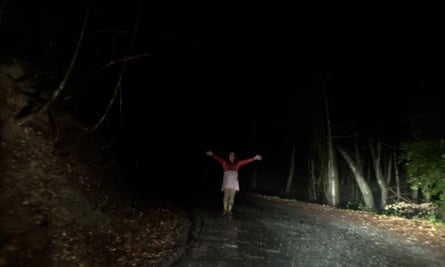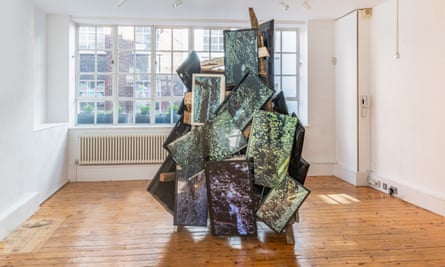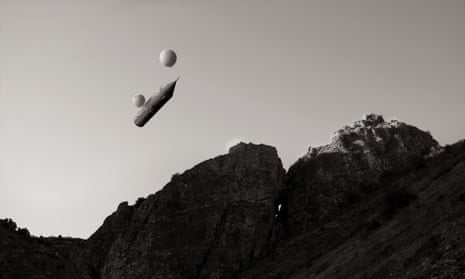Muttering often accompanies Kutluğ Ataman’s work, though usually it comes from the art itself. My first encounter with the Turkish artist and film-maker came with the 1999 video work Women Who Wear Wigs. Four characters told their stories on adjacent screens: a political activist obliged to disguise herself, a trans woman who had suffered abuse from the police, a chemotherapy patient, and a devout Muslim student banned from wearing a headscarf at a secular university. Each spoke insistently. It took effort to tune in and pay attention.
The last major work I saw of Ataman’s – Küba (2004) – was in a warehouse in the Antwerp docks. Each of 40 old TV monitors broadcast an account given by a resident of Küba, one of Istanbul’s many informal, unlicensed neighbourhoods (the structures are known as gecekondu – literally “night built”). Stationed opposite the TV sets, armchairs invited you to sit and listen to individual stories among the hubbub. Bound up in the presentation were ideas about what it meant to focus amid clamour, and to make time to listen in the busy city. There was, implicitly, also a deeper question about why it took an art installation to achieve this.
But there is also muttering of a more insidious kind. Since the rise to power of the Islamist populist Recep Tayyip Erdoğan (president since 2014, the country’s prime minister for 11 years prior) Turkey has been a dangerous environment for dissenting voices, and an increasingly hostile one for the LGBT community. Ten years ago, Ataman turned his back on Istanbul’s art scene, and a flourishing international career, and went to tend land in rural Anatolia. This show – split between a little first-floor gallery and a shop-front space in London’s Soho – is his return.

While he may have stepped away from the art world, Ataman is still steeped in its references. The central work here The Stream is a conceptual companion to Nam June Paik’s classic Fire Piece (1992). The Paik work was a low mound of black TV monitors, smashed and whole, transmitting colour footage of flames. Ataman answers Paik’s fire with water: 20 old screens strapped to a rustic wooden frame show the artist digging irrigation ditches.
While the tech in the gallery is new(ish), the vibe on screen is Old Testament. Ataman is barefoot on stony ground, gouging ditches with an old metal-headed hoe. The monitors are positioned so that the water, when it comes, flows upward, as if he were summoning some kind of miracle from the ancient soil. The hubbub of voices from Ataman’s earlier works is replaced by the insistent sound of metal on wet rubble.
Shown nearby are black and white photographs of Anatolian villagers apparently turning their local minaret into a rocket and floating it into space. Taken from Ataman’s sharp 2009 mockumentary Journey to the Moon, the photographs remind us that this artist’s films and images are not always what they seem.

Just in case we haven’t kept our wits about us, the other half of the show (presented in a second space) is called “fiction” – though again, how much we should trust that declaration is unclear. The most stirring works appear to be documentary photographs of badly beaten women in flimsy outfits walking in a desperate state along forest roads in the darkness. This series, Other Planets, was made during production of a feature film for which Ataman worked with trans people, recreating episodes of abuse they experienced in Turkey during the 1990s. These are complicated artefacts. As production photographs, they are indeed fiction. They are also records of real, traumatic, events.
Do real life and cinematic fiction inevitably leak into one another, however incompatible the pairing might be? In a series of sculptural objects, cartoonish stills from the 1960s Turkish B movie Kilink are pasted to the undersides of scrappy bits of wooden furniture, together with fetishised items of underwear (a suspender belt, sheer stockings). The scenarios in the stills are preposterous – a villain disguised in a skeleton suit accosting young women in intimate apparel – yet they seem to have integrated themselves into a person’s home life, perhaps stirring sexual memories.
The final work in this gallery of film references might be there for the title alone: a mop-like white wig floats on a dark screen, its fine tendrils every so often disturbed by someone breathing beneath the hair. The work shares its title with Samuel Fuller’s 1963 state-of-the-nation thriller Shock Corridor, which questions the power an individual has to transcend an oppressive environment. This, then, offers an overarching theme: how do you learn about sex when discussion is taboo? How do you construct a trans identity when every element of your person is threatened? How do you learn to draw water from stony ground?
Kutluğ Ataman: Mesopotamian Dramaturgies & Fiction is at Niru Ratnam Gallery, London, until 15 May.

Comments (…)
Sign in or create your Guardian account to join the discussion